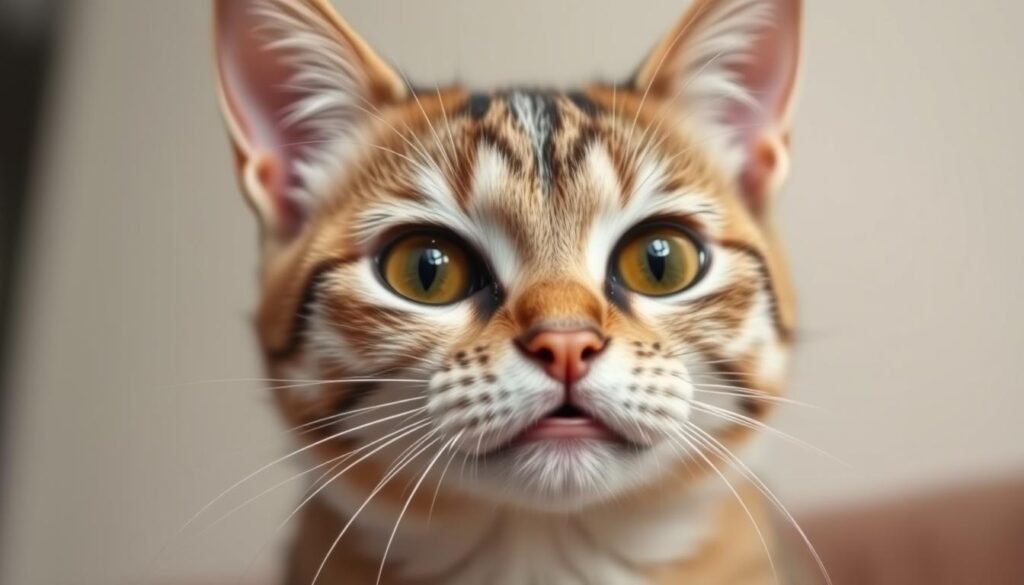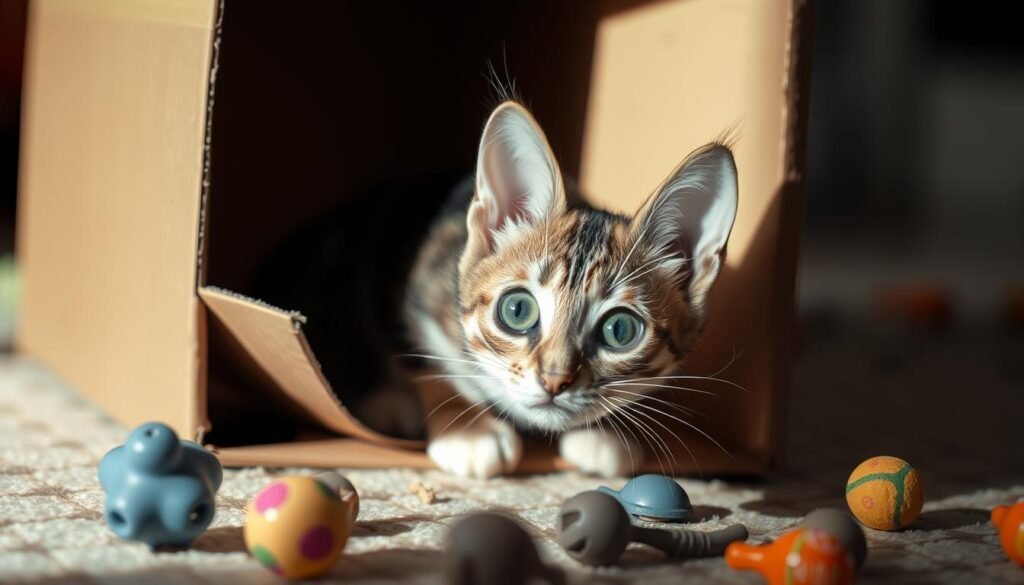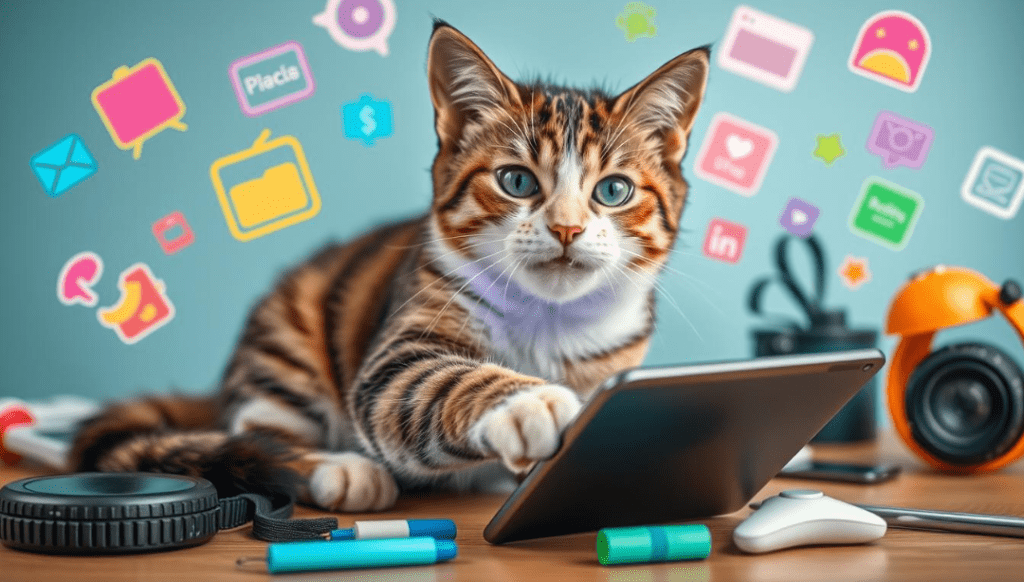A study in Behavioral Processes found cats can show nearly 300 different facial expressions. Some of these are truly priceless. Cats’ faces can look like they’re feeling silly, happy, or even shocked.
But what does it really mean when a cat looks at us with a certain expression? Cats don’t show emotions like humans do. So let’s explore some of the funniest cat faces and what they might be trying to say.

The Science Behind Cat Facial Expressions
Cats are amazingly expressive, and a recent study has shown just how varied their facial expressions can be. Researchers from Lyon College in Arkansas found 276 different facial expressions in domestic cats. This highlights the complexity of feline communication.
The study, published in the journal Behavioural Processes, watched 53 cats at a local cat café for 150 hours. They used the Facial Action Coding System (CatFACS) to find 26 unique muscle movements. These movements were mixed to create the 276 facial expressions seen.
“Cats are very expressive animals,” says study co-author Brittany Florkiewicz, PhD, an evolutionary psychologist at Lyon College. “People who’ve had cats probably won’t be surprised by that, but what is surprising is the number of expressions they make, especially when you compare it to other species.”
The study found that 45.7% of the coded expressions were categorized as friendly, while 37% were identified as aggressive. The remaining 18% were deemed ambiguous, falling into both categories. Friendly expressions include ears and whiskers moving forward with closed eyes. Aggressive cats show constricted pupils, flattened ears, and a tongue-swipe of the lip.
Understanding cat body language and facial expressions helps us better understand our feline friends. It lets us interpret their behavior and meet their needs and emotions more effectively.
Relaxed and Happy Cat Facial Expression
When your cat’s face looks calm, they’re likely feeling relaxed and happy. Cats that feel at home often seem calm and lazy. They might be lounging or curled up in a ball.
A relaxed cat shows signs like forward-facing ears and half-closed eyes. Their mouth is closed, and their whiskers rest gently on their face.
A happy cat might slow blink at you. This means they trust and love you. It’s a special way to bond with your cat.
Typical Signs of a Relaxed Cat
- Relaxed, forward-facing ears
- Half-closed or shut eyes with small pupils
- Closed, relaxed mouth
- Whiskers gently resting on the face
Cats have up to 276 cat facial expressions to talk to us. Knowing these signs helps you understand your cat better. It strengthens your bond with gentle touches and cuddles.

“A great bonding exercise is slowly blinking while looking at your cat, which in cat language means ‘I trust you so much that I can close my eyes while you are there – I like you a lot.'”
Alert Cat Facial Expression
Cats may look cute, but they have a wild side. Their ancestors were silent hunters. They would sneak up on their prey, ready to pounce at the first sign of weakness. This alert look is still in our cats, especially when they see something new.
When a cat is alert, they look more careful. Their feet are ready to run or jump. You’ll see pricked ears, open eyes, a closed mouth, and forward-pointed whiskers. It’s hard to get their attention because they’re focused on what’s happening.
“Cats have 32 facial muscles, allowing for a wide range of facial expressions, which is 12 more than humans.”
Knowing when a cat is alert is key for pet owners. It shows they’re cautious or watching for dangers. By noticing these signs, we can meet our cats’ needs better. This strengthens our bond with them.

Cats show many emotions with their faces. They can look relaxed or alert. Learning these expressions helps us understand them better. It deepens our connection with our cat friends.
Stressed Cat Facial Expressions
We all love our feline friends, but it’s key to know when they’re stressed. Stressed cats show unique facial expressions that tell us how they’re feeling. By catching these signs, we can help our cat friends feel better.
Typical Signs of a Stressed Cat
A stressed cat might have slumped ears or a closed-off body. They might also avoid people or show aggression like constant meowing or hissing. They might not want to play or interact with their humans.
- Flattened or turned back ears
- Wide, dilated pupils
- Whiskers pulled back or pushed forward
- Tension in the muzzle
If you see these cat facial expressions, talk to a vet or a cat behaviorist. They can find out why your stressed cat is feeling this way. Then, they can help make a calmer space for your stressed cat.

“Understanding and interpreting cat facial expressions can enhance the bond and well-being of feline companions.”
Cat Facial Expressions
Cats are experts at showing their feelings through facial expressions. They use these expressions to communicate a lot. Their faces can tell us a lot about how they’re feeling.
When a cat feels worried or anxious, they might hide. They show this by having their ears up and one tilted, wide eyes, a closed mouth, and forward-pointing whiskers. They usually don’t like to be touched when they’re feeling this way.
Cats can also get depressed from too much stress. An unhappy cat has ears that droop but don’t flatten, wide eyes looking down, a closed mouth, and droopy whiskers. They might sleep a lot, groom less, and not want to do things they used to enjoy.

“Cats have 26 different facial movements that combine to make 276 distinct expressions, making them more subtle in expressing themselves compared to dogs.”
Understanding feline expressions improves cat care, rescue efforts, vet visits, and our relationships with cats. With patience and attention, we can learn to read their complex language. This deepens our connection and appreciation for these amazing animals.
Worried or Anxious Cat Facial Expression
Our curious cats are always on the lookout. They use their facial expressions to tell us how they feel. When they see something scary, their faces show us what’s going on inside. Let’s look at the signs of a worried cat or an anxious cat.
One key sign is their ears. A worried or anxious cat will have their ears up and one slightly to the side. This makes them look very alert and watchful.
Also, their eyes will get bigger, and their pupils will get wider. This helps them see more around them. And they might keep their mouth closed tightly, showing they’re stressed or worried.
- Pricked, asymmetrical ears
- Wide eyes with dilated pupils
- Closed, tight-lipped mouth
Cats are naturally cautious, so they might show these worried or anxious cat facial expressions when they’re scared or unsure. It’s important to be patient and gentle with them. This helps them feel safe and secure.

“A cat’s expression is far more subtle and nuanced than a dog’s, and understanding it is crucial for their well-being.”
Depressed Kitty Facial Expression
Cats can indeed feel depressed, often due to stress. A depressed cat shows signs in their face that can help us notice when they’re feeling down.
Typical Signs of an Unhappy Cat
An unhappy cat may have drooping ears and open eyes that look down. They might also have a closed mouth and droopy whiskers. These cat facial expressions show they’re not interested, tired, and unhappy.
Seeing these feline expressions is key for cat owners to know when their pet is struggling. Giving them more love, attention, and things to do can help improve their mood and fight depression.
“Cats are really good at hiding their feelings. If you have any concerns as to whether the cat is unwell or just being a little shy, please ask the owner.”
As the quote says, it’s crucial for cat sitters and others to watch for signs of distress in a cat’s face. Being proactive can greatly help in keeping the cat’s well-being and solving any problems early on.

Friendly vs Non-Friendly Expressions
Cats are known for their expressive faces. Research has shown that domesticated cats have many facial movements. They can show a total of 276 unique combinations of expressions.
This study found that 46% of these expressions are friendly. On the other hand, 37% are used when cats are unfriendly or aggressive. The remaining 18% mix both friendly and unfriendly signals.
To know if a cat is friendly, look at its ears, whiskers, and mouth. Whiskers pointing forward usually mean a happy cat.
“Domesticated cats are very socially flexible compared to wild cats, who are very solitary,” says Florkiewicz. “Having a wide range of facial expressions was probably great for navigating different kinds of social interactions.”
The study watched 27 female and 26 male domestic shorthair cats for 10 months. They recorded 688 facial signals aimed at other cats. This research gives us a deeper look into cat facial expressions and how they communicate.

The Sleepy “Smile”
When your cat is dreaming, their face relaxes, and their lips curl up. This makes them look like they’re smiling. But cats don’t smile like humans do.
Studies show that cats have their own ways to show feelings. They do this by slowly blinking at us or other cats. This blinking is like a cat smile, showing they’re friendly and happy.
Cats come from dry places with big areas. They don’t need to show feelings with their faces. Instead, they use their tails, ears, and voices to show how they feel. The feline expressions they do show, like the sleepy smile, reflect their mood.
“Cats don’t engage in smiling behavior like humans, but instead show contentment through behaviors such as narrowing their eyes, slow blinking, dilated pupils, and body language like purring, bunting, and playfulness.”
So when you see your sleepy cat smiling, it’s just their relaxed face. It’s not a real smile. But it’s still a sweet sight that shows how peaceful and happy our cats are.

The Stink-Face
If you have a cat, you’ve seen the funny “stink-face” they make. This look comes from a cool thing called the flehmen response. Cats use it to learn about smells, like pheromones from other cats or new smells around them.
When a cat finds an interesting smell, they open their mouth a bit. They curl back their top lip and take a deep breath. This lets the scent reach the Jacobson’s organ in their mouth. The Jacobson’s organ helps cats understand pheromones and other smells, giving them info about their world.
The stink-face doesn’t mean your cat is disgusted or about to sneeze. It’s just a natural way for them to explore their surroundings with their amazing sense of smell. In homes with more than one pet, cats might use this face to say they’re uncomfortable or need some space.
“Cats have an exceptional sense of smell, which can lead to the ‘stink face’ expression when they come across overwhelming or intriguing scents.”
So when your cat makes a stink-face, they’re not showing disgust. They’re using a cool cat facial expression and feline expression to understand their world better through their sense of smell.

Purr-ting Thoughts
Cats may not show their feelings as openly as dogs do. But they have many cat facial expressions that tell us a lot. These expressions range from a calm “cat smile” to a tight “stink face.”
Understanding cat communication and cat body language helps us connect better with our cats. It makes our bond stronger. Whether you’ve had a cat for years or just got one, knowing their facial signals is key.
So when your cat looks puzzled or smiles at you, appreciate their unique cat facial expressions. With some attention and love, you’ll soon understand what they’re trying to say.





